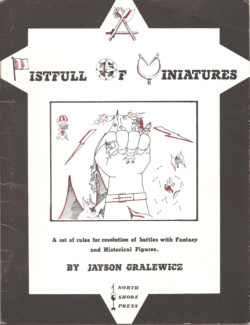|
|
||||||
 |
|
The Rules Directory only works if you help. Write a review. Get the review template here. |
|
TITLE: A Fistfull of Miniatures AUTHOR: Jayson Gralewicz PUBLISHER: North shore press PUBLICATION DATE: 1986 WEB SITE/SUPPORT FORUM: None PRICE (with date): $6.95 (in 1986) REVIEWED BY: Mark “Extra Crispy” Severin PERIOD COVERED: Fantasy THE BOOK: A Fistfull of Miniatures (AFFOM) is a slim booklet of just 24 pages with a card stock cover. Included in my set, purchased used, is a 8.5 x 11” cheat sheet with charts on one side and the turn sequence on the other. SCOPE: AFFOM is designed to handle mass battles between fantasy armies. ARMY SIZE: 100+ figures. AFFOM is designed to let you use your entire miniatures collection in the ultimate mass combat showdown. BASE UNIT: Figures in AFFOM are either formed into units of several stands, or used as single figures (leaders, wizards, dragons, etc.). GAME SCALES:
BASING SIZES: All units are categorized into a few troop types mounted as follows:
TURN SEQUENCE:
GAME MECHANICS: Troop Ratings: AFFOM has a simple rating system that allows you to use any figures very easily. Units are either lightly armored or heavily armored, and there are only a few weapon types: hand weapons, Vunder (2 handed swords, lances, pikes etc.) and missile weapons (broken down into bows, long bows, and cross bows). Units may have Elite, Regular or Poor morale. AFFOM includes a points-based army building system in which you simply “buy” each stand and leader for your army. In general all stands are equal. Whether they are wolf riders or centaurs, any one stand of troops is equal to any other similar stand. Charges: Charges are really better called “move to contact.” In the charge phase Side A’s charging units move 1/2, the defender announces any counter charges and may fire at any enemy units that did not make contact. Repeat for side B. the Side A moves charger the remainder of their charge, followed by Side B. Units may only make contact in this phase, not at any other time during the turn. Charges must be in a straight line, may not go uphill or through most broken terrain. Movement: Movement is very simple in keeping with the aim of the rules. units must be in line or column formation. Movement rates depend on the kind of unit and formation they are in. Units pay pivot at the beginning of their move at no cost - up to 45o. Formation changes cost half a move. Units may about face and oblique up to 30o. Missile Fire: To conduct missile fire, a player rolls one Average Die, modifies it for range, leadership, target type, moving fire etc. The result is multiplied by the number of stands in the unit. The total is then divided by 20 and rounded to the nearest integer. This is the number of stands eliminated from the target. Melee: Melee is resolved exactly like Missile Fire. The modifiers are different, of course. In melee only stands in contact are counted, though a unit may overlap by one stand. Stands in a second rank behind a contacting stand are themselves considered contacting and count toward the result. An Average Die is rolled, modified for leadership, terrain, etc. and a final result tallied. This is multiplied by the number of stands and divided by 10. The result is the number of stands to be removed. Of course, in melee both sides roll and inflict casualties on each other. Each side then checks morale with the side suffering more losses checking first. If neither side breaks they will be locked in melee until the next turn. If one side routs, or is wiped out, the winner may pursue. It may make a half move, and may even contact a second unit and fight another melee. Leaders: Leaders are rated from +1 to +3 and because they add their bonus to combat dice can be quite deadly. They are also hard to kill as they get saving throws against losses and always count as a heavily armored target. Large monsters, such as dragons and trolls, are single figures that count as being made up of multiple stands. As such they are also very hard to kill without a good leader! Morale and Rally: Each unit is rated as either Elite, Regular or Poor. Elites check morale at +2, Poor at -2. To check morale roll 2D6 and apply modifiers from the Morale Table for leadership, unit rating, etc. You must roll lower than a target number which is based on the number of stands in your unit. A failure means the unit routs, does an about face, and retreats 1 full charge move away. Units rally in the Rally Phase by making a successful morale check. Routed units that rally also recover one stand worth of stragglers. Advanced Rules: The book includes a few advanced rules:’
ARMY LISTS/SCENARIOS: The book includes an appendix detailing numerous types of fantasy troops - Elves, Giants, Gargoyles, etc. Each type may have special bonuses or abilities. Elves, for example, get a +1 on bow fire and move through woods without penalty. REVIEWER’S COMMENTS: These are a very fast and breezy set of rules. The actual rules themselves run just 6 pages! PLAYER’S COMMENTS: Not played. |
|
[Home] [15mm World] [Reviews Home] [How To] [Beginners Guide] [Gamer's World] [Spanner & The Yank] [Points of View] [The Annex] [Links] [Say Howdy] [Corporate Schill] [Rules Directory] |
 |
